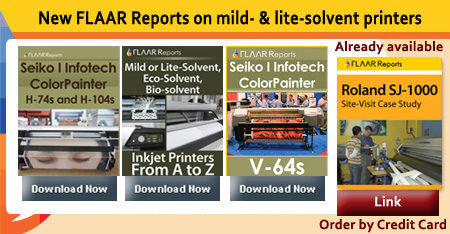The Kodak 4742 and 4760 the OEM versions of Mutoh.
Kodak, Agfa, Accuplot, SignWarehouse and several other companies re-brand the Mutoh printer. This is because Mutoh is the manufacturing company which makes the Epson 7000 and Epson 9000. Thus all Mutoh printers are simply a different size and shape version of those Epson printer. All Mutoh, Mimaki, and Roland printers use piezo-electric printheads manufactured by Epson. Mutoh printers are relabeled and sold rebranded as Kodak 4742, Kodak 4760 and by other companies such as Agfa.
What is the difference? Really the only major difference is the software RIP. The media is all more or less the same (relabeled and rebranded from the few companies that actually make their own paper). The ink is more or less all from just two or three chemical companies (HP excellent inks are reported to come from Dupont, for example). Kodak, however, does have several unique kinds of media that it's own labs have developed. Kodak EI is one of these highly regarded media.
It has been very confusing of us to keep track of what Kodak model number is which. It was even unclear which was a rebranded Encad model number, and which was a rebranded Mutoh.
We briefly cover the other Kodak large format printers, Kodak 2042, 2060, 3038, 3043 (OEM of Encad) on a separate page.
Kodak does not yet seem to have a solution for fine art giclee printing. Too bad, since Kodak is now the distributor for BetterLight scan backs, the ideal way to scan your paintings or other artwork. If you intend to reproduce paintings on inkjet canvas you can't scan your paintings on a flatbed (this equipment is too small). But if you get an overhead scanner (with a scan back) then you can handle digitizing objects of any size or shape. The recommended equipment is covered in the FLAAR report on scanners.
Also lacking is an entry-level Kodak printer. Here Epson does the best job of providing what the newbie and first-time user need, even better than Hewlett-Packard. HP has perfected the market for printers in corporate situations, and desktop printers for home use to some degree. But Kodak has no entries in the home and pro-sumer inkjet market.
So far it is unclear whether Kodak will rebrand the new generation of Mutoh printers, the Mutoh Falcon II. So far Agfa is the main company which has taken on this new Mutoh printer family.
To help you out we have prepared a series of reports that you can obtain at no-cost via e-mail.
For additional information and for help making your decision, ask for the "FLAAR report on signs, posters, banners" (specify whether for indoor signs or outdoor signs in the rain and sun). You can also ask for the report on "Media and Inks for Photo-Realistic and Fine Art Giclee," or "Media and Inks for Sign Printing with Large Format Inkjet."
If this will be your first printer, then we have a special report that holds your hand and leads you through all the basic questions that will assist a first-time buyer of a large format printer. Purchase the FLAAR report on "RIP + Help." This explains what RIP software is, why this is useful, and includes tips, warnings, information, and help for a wide range of matters for a newbie. Here you will really appreciate that FLAAR is based at a university; Professor Hellmuth has plenty of experience writing in a manner that explains what you need, and why.
If you really want technical details on inkjet media, inks, and/or inkjet printhead technology, and especially if you wish to meet the movers and shakers in this industry, be sure to sign up for the next conference organized by IMI. Their contact is [email protected]. These seminars are outstanding; the senior review editor of FLAAR usually attends because he can get so much fresh information for the readers of the FLAAR Reports in PDF format and the FLAAR Information Network of web sites.
Most recently updated June 1, 2002.
Previous updates: August 02, 2001.
 |